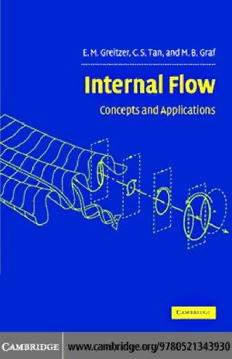Table Of ContentInternal Flow
Thisbookdescribestheanalysisandbehaviorofinternalflowsencounteredinpropulsion
systems,fluidmachinery(compressors,turbines,andpumps)andducts(diffusers,nozzles
and combustion chambers). The focus is on phenomena that are important in setting the
performanceofabroadrangeoffluiddevices.
Theauthorsshowthatevenforcomplexprocessesonecanlearnagreatdealaboutthe
behaviorofsuchdevicesfromaclearunderstandingandrigoroususeofbasicprinciples.
Throughout the book they illustrate theoretical principles by reference to technological
applications.Thestrongemphasisonfundamentals,however,meansthattheideaspresented
canbeappliedbeyondinternalflowtoothertypesoffluidmotion.
Thebookequipsstudentsandpractisingengineerswitharangeofanalyticaltools,which
offerenhancedinterpretationandapplicationofbothexperimentalmeasurementsandthe
computationalproceduresthatcharacterizemodernfluidsengineering.
EdwardM.GreitzerreceivedhisPh.D.fromHarvardUniversityandistheH.N.SlaterProfessor
ofAeronauticsandAstronauticsattheMassachusettsInstituteofTechnology.Hespentten
yearswithUnitedTechnologiesCorporation,atPratt&WhitneyandUnitedTechnologies
ResearchCenter.HehasbeenamemberoftheUSAirForceScientificAdvisoryBoard,the
NASAAeronauticsAdvisoryCommittee,andDirectoroftheMITGasTurbineLaboratory.
Heisathree-timerecipientoftheASMEGasTurbineAward,anASMEFreemanScholarin
FluidsEngineering,afellowofAIAAandASME,andamemberoftheNationalAcademy
ofEngineering.
ChoonSooiTan received his Ph.D. from the Massachusetts Institute of Technology and is
currentlyaSeniorResearchEngineerintheGasTurbineLaboratoryatMIT.
Martin B. Graf received his Ph.D. from the Massachusetts Institute of Technology and is
currentlyaProjectManagerattheconsultingfirmMars&Company.BeforejoiningMars
hewaswiththePratt&WhitneyDivisionofUnitedTechnologiesCorporation.
Internal Flow
Concepts and Applications
E. M. Greitzer
H.N.SlaterProfessorofAeronauticsandAstronautics
MassachusettsInstituteofTechnology
C. S. Tan
MassachusettsInstituteofTechnology
and
M. B. Graf
Mars&Company
cambridge university press
Cambridge, New York, Melbourne, Madrid, Cape Town, Singapore, São Paulo
Cambridge University Press
The Edinburgh Building, Cambridge cb2 2ru, UK
Published in the United States of America by Cambridge University Press, New York
www.cambridge.org
Information on this title: www.cambridge.org/9780521343930
© Cambridge University Press 2004
This publication is in copyright. Subject to statutory exception and to the provision of
relevant collective licensing agreements, no reproduction of any part may take place
without the written permission of Cambridge University Press.
First published in print format 2004
isbn-13 978-0-511-19553-2 eBook (NetLibrary)
isbn-10 0-511-19553-2
eBook (NetLibrary)
isbn-13 978-0-521-34393-0 hardback
isbn-10 0-521-34393-3 hardback
Cambridge University Press has no responsibility for the persistence or accuracy of urls
for external or third-party internet websites referred to in this publication, and does not
guarantee that any content on such websites is, or will remain, accurate or appropriate.
Contents
Preface page xvii
Acknowledgements xx
Conventionsandnomenclature xxii
1 Equationsofmotion 1
1.1 Introduction 1
1.2 Propertiesofafluidandthecontinuumassumption 2
1.3 Dynamicandthermodynamicprinciples 2
1.3.1 Therateofchangeofquantitiesfollowingafluidparticle 3
1.3.2 Massandmomentumconservationforafluidsystem 4
1.3.3 Thermodynamicstatesandstatechangeprocessesfor
afluidsystem 4
1.3.4 Firstandsecondlawsofthermodynamicsforafluidsystem 6
1.4 Behavioroftheworkingfluid 8
1.4.1 Equationsofstate 8
1.4.2 Specificheats 9
1.5 Relationbetweenchangesinmaterialandfixedvolumes:Reynolds’s
TransportTheorem 11
1.6 Conservationlawsforafixedregion(controlvolume) 13
1.7 Descriptionofstresswithinafluid 15
1.8 Integralformsoftheequationsofmotion 19
1.8.1 Force,torque,andenergyexchangeinfluiddevices 19
1.9 Differentialformsoftheequationsofmotion 20
1.9.1 Conservationofmass 24
1.9.2 Conservationofmomentum 25
1.9.3 Conservationofenergy 26
1.10 Splittingtheenergyequation:entropychangesinafluid 26
1.10.1 Heattransferandentropygenerationsources 27
1.11 Initialandboundaryconditions 28
1.11.1 Boundaryconditionsatsolidsurfaces 29
1.11.2 Inletandoutletboundaryconditions 30
1.12 Therateofstraintensorandtheformofthedissipationfunction 31
1.13 Relationshipbetweenstressandrateofstrain 34
vi Contents
1.14 TheNavier–Stokesequations 37
1.14.1 Cartesiancoordinates 38
1.14.2 Cylindricalcoordinates 39
1.15 Disturbancepropagationinacompressiblefluid:thespeedofsound 40
1.16 Stagnationandstaticquantities 41
1.16.1 RelationofstagnationandstaticquantitiesintermsofMach
number 42
1.17 Kinematicanddynamicflowfieldsimilarity 43
1.17.1 Incompressibleflow 43
1.17.2 Kinematicsimilarity 44
1.17.3 Dynamicsimilarity 44
1.17.4 Compressibleflow 45
1.17.5 LimitingformsforlowMachnumber 46
2 Someusefulbasicideas 48
2.1 Introduction 48
2.2 Theassumptionofincompressibleflow 48
2.2.1 Steadyflow 49
2.2.2 Unsteadyflow 51
2.3 Upstreaminfluence 51
2.3.1 Upstreaminfluenceofacircumferentiallyperiodic
non-uniformity 52
2.3.2 Upstreaminfluenceofaradialnon-uniformityinanannulus 54
2.4 Pressurefieldsandstreamlinecurvature:equationsofmotioninnatural
coordinates 56
2.4.1 Normalandstreamwiseaccelerationsandpressuregradients 56
2.4.2 Otherexpressionsforstreamlinecurvature 57
2.5 Quasi-one-dimensionalsteadycompressibleflow 60
2.5.1 Correctedflowperunitarea 61
2.5.2 Differentialrelationsbetweenareaandflowvariablesforsteady
isentropicone-dimensionalflow 63
2.5.3 Steadyisentropicone-dimensionalchannelflow 65
2.6 Shockwaves 65
2.6.1 Theentropyriseacrossanormalshock 66
2.6.2 Shockstructureandentropygenerationprocesses 68
2.7 Effectofexitconditionsonsteady,isentropic,one-dimensional
compressiblechannelflow 71
2.7.1 Flowregimesforaconvergingnozzle 72
2.7.2 Flowregimesforaconverging–divergingnozzle 74
2.8 Applicationsoftheintegralformsoftheequationsofmotion 76
2.8.1 Pressureriseandmixinglossesatasuddenexpansion 76
2.8.2 Ejectorperformance 78
vii Contents
2.8.3 Fluidforceonturbomachineryblading 80
2.8.4 TheEulerturbineequation 83
2.8.5 Thrustforceonaninlet 84
2.8.6 Thrustofacylindricaltubewithheatingorcooling
(idealizedramjet) 86
2.8.7 Obliqueshockwaves 87
2.9 Boundarylayers 89
2.9.1 Featuresofboundarylayersinducts 89
2.9.2 Theinfluenceofboundarylayersontheflowoutsidethe
viscousregion 91
2.9.3 Turbulentboundarylayers 94
2.10 Inflowandoutflowinfluiddevices:separationandtheasymmetryofreal
fluidmotions 94
2.10.1 Qualitativeconsiderationsconcerningflowseparationfrom
solidsurfaces 94
2.10.2 Thecontrastbetweenflowinandoutofapipe 96
2.10.3 Flowthroughabenttubeasanillustrationoftheprinciples 98
2.10.4 Flowthroughasharpedgedorifice 100
3 Vorticityandcirculation 104
3.1 Introduction 104
3.2 Vorticitykinematics 105
3.2.1 Vortexlinesandvortextubes 107
3.2.2 Behaviorofvortexlinesatasolidsurface 110
3.3 Vorticitydynamics 111
3.4 Vorticitychangesinanincompressible,uniformdensity,inviscidflow
withconservativebodyforce 112
3.4.1 Examples:Secondaryflowinabend,horseshoevortices
upstreamofstruts 114
3.4.2 Vorticitychangesandangularmomentumchanges 117
3.5 Vorticitychangesinanincompressible,non-uniformdensity,inviscid
flow 119
3.5.1 Examplesofvorticitycreationduetodensitynon-uniformity 121
3.6 Vorticitychangesinauniformdensity,viscousflowwithconservative
bodyforces 122
3.6.1 Vorticitychangesandviscoustorques 124
3.6.2 Diffusionandintensificationofvorticityinaviscousvortex 125
3.6.3 Changesofvorticityinafixedvolume 127
3.6.4 Summaryofvorticityevolutioninanincompressibleflow 128
3.7 Vorticitychangesinacompressibleinviscidflow 128
3.8 Circulation 130
viii Contents
3.8.1 Kelvin’sTheorem 130
3.9 Circulationbehaviorinanincompressibleflow 132
3.9.1 Uniformdensityinviscidflowwithconservativebodyforces 132
3.9.2 Incompressible,non-uniformdensity,inviscidflowwith
conservativebodyforces 134
3.9.3 Uniformdensityviscousflowwithconservativebodyforces 135
3.10 Circulationbehaviorinacompressibleinviscidflow 135
3.10.1 Circulationgenerationduetoshockmotionina
non-homogeneousmedium 135
3.11 Rateofchangeofcirculationforafixedcontour 137
3.12 Rotationalflowdescriptionsintermsofvorticityandcirculation 138
3.12.1 BehaviorofvortextubeswhenD(cid:2)/Dt=0 139
3.12.2 Evolutionofanon-uniformflowthroughadiffuserornozzle 140
3.12.3 Trailingvorticityandtrailingvortices 142
3.13 Generationofvorticityatsolidsurfaces 144
3.13.1 Generationofvorticityinatwo-dimensionalflow 145
3.13.2 Vorticityfluxinthinshearlayers(boundarylayersandfree
shearlayers) 149
3.13.3 Vorticitygenerationataplanesurfaceinathree-dimensional
flow 151
3.14 Relationbetweenkinematicandthermodynamicpropertiesinan
inviscid,non-heat-conductingfluid:Crocco’sTheorem 152
3.14.1 ApplicationsofCrocco’sTheorem 153
3.15 Thevelocityfieldassociatedwithavorticitydistribution 156
3.15.1 Applicationofthevelocityrepresentationtovortextubes 158
3.15.2 Applicationtotwo-dimensionalflow 159
3.15.3 Surfacedistributionsofvorticity 159
3.15.4 Somespecificvelocityfieldsassociatedwithvortexstructures 160
3.15.5 Numericalmethodsbasedonthedistributionofvorticity 163
4 Boundarylayersandfreeshearlayers 166
4.1 Introduction 166
4.1.1 Boundarylayerbehavioranddeviceperformance 167
4.2 Theboundarylayerequationsforplaneandcurvedsurfaces 170
4.2.1 Planesurfaces 170
4.2.2 Extensiontocurvedsurfaces 173
4.3 Boundarylayerintegralquantitiesandtheequationsthatdescribethem 173
4.3.1 Boundarylayerintegralthicknesses 173
4.3.2 Integralformsoftheboundarylayerequations 176
4.4 Laminarboundarylayers 177
4.4.1 Laminarboundarylayerbehaviorinfavorableandadverse
pressuregradients 177
ix Contents
4.4.2 Laminarboundarylayerseparation 179
4.5 Laminar–turbulentboundarylayertransition 182
4.6 Turbulentboundarylayers 184
4.6.1 Thetimemeanequationsforturbulentboundarylayers 184
4.6.2 Thecompositenatureofaturbulentboundarylayer 187
4.6.3 Introductorydiscussionofturbulentshearstress 189
4.6.4 Boundarylayerthicknessandwallshearstressinlaminarand
turbulentflow 191
4.6.5 Vorticityandvelocityfluctuationsinturbulentflow 193
4.7 Applicationsofboundarylayeranalysis:viscous–inviscidinteractionin
adiffuser 195
4.7.1 Qualitativedescriptionofviscous–inviscidinteraction 197
4.7.2 Quantitativedescriptionofviscous–inviscidinteraction 198
4.7.3 Extensionsofinteractiveboundarylayertheorytoother
situations 201
4.7.4 Turbulentboundarylayerseparation 201
4.8 Freeturbulentflows 202
4.8.1 Similaritysolutionsforincompressibleuniform-densityfree
shearlayers 202
4.8.2 Themixinglayerbetweentwostreams 205
4.8.3 Theeffectsofcompressibilityonfreeshearlayermixing 208
4.8.4 Appropriatenessofthesimilaritysolutions 210
4.9 Turbulententrainment 211
4.10 Jetsandwakesinpressuregradients 212
5 Losssourcesandlossaccounting 217
5.1 Introduction 217
5.2 Lossesandentropychange 218
5.2.1 Lossesinaspatiallyuniformflowthroughascreen
orporousplate 218
5.2.2 Irreversibility,entropygeneration,andlostwork 220
5.2.3 Lostworkaccountinginfluidcomponentsandsystems 222
5.3 Lossaccountingandmixinginspatiallynon-uniformflows 225
5.4 Boundarylayerlosses 227
5.4.1 Entropygenerationinboundarylayersonadiabaticwalls 227
5.4.2 Theboundarylayerdissipationcoefficient 230
5.4.3 Estimationofturbomachinerybladeprofilelosses 233
5.5 Mixinglosses 234
5.5.1 Mixingoftwostreamswithnon-uniformstagnationpressure
and/ortemperature 234
5.5.2 ThelimitingcaseoflowMachnumber(M2(cid:3)1)mixing 237

